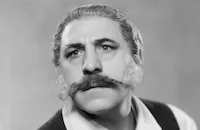Too Much Harmony
Cast & Crew
Edward Sutherland
Bing Crosby
Jack Oakie
Richard "skeets" Gallagher
Harry Green
Judith Allen
Film Details
Technical Specs

Synopsis
Following the end of a successful run of Max Merlin's Cocktails of 1932 in Chicago, singer Eddie Bronson flies to New York and gets sidetracked in Ohio, where he meets vaudevillians Johnny Dixon, Benny Day and Benny's sweetheart, Ruth Brown, whose act is called "Dixon and Day." Eddie promises them all work with Merlin in order to cast Ruth in Cocktails of 1933 . Eddie is engaged to gold digger Lucille Watkins, who has a bad reputation. When Lucille sees Ruth admiring Eddie, she deceitfully tells Johnny that Eddie is a playboy. Following three weeks of rehearsal, Eddie tells Lucille that he loves Ruth, and she insists that he marry her within twenty-four hours, or else she will create a front-page scandal. Merlin's veteran actress/comedienne Patsy Dugan then tells Benny that Eddie is really a decent guy. Realizing that he and Ruth do not love each other, Benny agrees to help Patsy rid Eddie of Lucille, who earlier ruined Patsy's marriage with society man Charles W. Beaumont. After Patsy convinces Lucille that Benny is Charles Beaumont, Jr., the tobacco millionaire who is backing the show, "Charles" and Lucille make a date for opening night. During the performance, Ruth visits Eddie's dressing room and swears her love. Benny visits and leaves in tears. Following his number with Johnny, Benny rushes to his date with Lucille, who is drunk, and then returns for the finale. Lucille breaks her engagement with Eddie, then learns too late that "Charles" was a fake. Benny has a sweet parting from Ruth, who joins Eddie for the finale and then kisses him.

Director
Edward Sutherland
Cast

Bing Crosby

Jack Oakie
Richard "skeets" Gallagher
Harry Green
Judith Allen

Lilyan Tashman

Ned Sparks
Kitty Kelly
Grace Bradley
Mrs. Evelyn Offield Oakie

Henry Armetta
Anna Demetrio
Del Henderson

Billy Bevan

Shirley Grey
Red Corcoran
Sammy Cohen
Cyril Ring
Crew
Eddie Adams
Francis Burgess
Sam Coslow
Richard Currier
Hans Dreier
J. A. Goodrich
Arthur Johnston
William Lebaron
Joseph L. Mankiewicz
Robert Odell
Leroy Prinz
Harry Ruskin
Theodor Sparkuhl
Frank Titus
Buddy Williams

Film Details
Technical Specs

Quotes
Trivia
Notes
According to a news item in Hollywood Reporter on May 17, 1933, this film was a sequel to the 1929 film Close Harmony, Paramount's first musical. The 1929 film was directed by John Cromwell and Edward Sutherland, starred Nancy Carroll and Charles "Buddy" Rogers, and featured Jack Oakie, Skeets Gallagher and Harry Green (see AFI Catalog of Feature Films, 1921-30; F2.0924). According to a news item in Hollywood Reporter on June 7, 1933, failure to find an ingenue who could sing delayed the start of production; director Eddie Sutherland reportedly haunted nightclubs and radio stations the first week of Jun, with "disappointing results." Hollywood Reporter reported on 21 June that Paramount rewrote the script in order to enlarge Bing Crosby's role following the success of College Humor, which had a general release date of June 23, 1933. Hollywood Reporter also reported on 21 June that Paul Jones, an assistant director at Paramount, would be working with Edward Sutherland to supply "gags and bits of business" and to make suggestions on the set. Jones does not receive credit on the screen, however, and it is unclear what contribution he made to the final film. Mrs. Evelyn Offield Oakie was Jack Oakie's mother.












